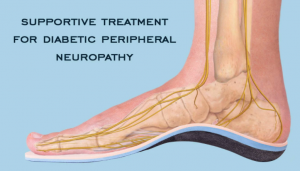Treatment for knee discomfort caused by flat feet
If you’re experiencing back discomfort, shin splints, knee pain, or hip pain, start with your feet. These issues appear to be unrelated, but according to foot experts, they are all linked to issues that begin with the feet and how they are constructed.
Many persons with flat feet, for example, complain of pain in the Achilles tendon in the foot and ankle area. This pain can migrate to the legs, causing problems with the knees and hips. Many people do not realize that the source of their discomfort is in their feet, even if they have had knee, hip, and neck trouble.
A lack of tendon support in the foot arch can create flat feet, which are widespread. The integrity of the foot might be jeopardized by falling down the floor, also known as hyperpronation or overpronation. What happens subsequently disrupts both the foot and leg’s biomechanics, resulting in a slew of stress ailments that can leave you limber but confined in bed.

Flat feet can cause pain in the back, hips, and knees, among other areas of the body. A diminished arch of the foot, soreness in weight absorption, and weariness on the inside of the foot and in the arches are the most common symptoms of flat feet.
There may be no need to be concerned if there is no major pain in other feet, ankles, or legs, and no anomalies are causing your flat feet. Flat feet, on the other hand, may be addressed if they cause pain elsewhere in the body or if they are the result of an underlying illness.
Many persons with flexible flat feet, on the other hand, have an arch that is evident when the foot is elevated but disappears when the foot is placed on the floor. Some people appear to have no trouble with a lower bow or no bow at all.
Flat feet can arise in those who have a low or non-existent arch, according to Pinterest shares. Flexible flat feet might deteriorate with age, causing one or both bows to collapse.
Flat feet are defined by a low or absent arch, which implies one or both feet are flat on the ground. When these individuals stand or walk, their feet roll inward.
A tear of the leg tendons, particularly the posterior shin tendon that supports the arch of the foot, is the most prevalent cause of inflammation. The ligaments in the arch of the foot (the three) can rupture or relax as we age, causing the arch to fall off and causing foot pain in many people. Because the bow appears when you lift your foot up, you may not notice it.
The rest of our body redistribute our weight when the arches of our feet change. Flat feet and collapsing arches create discomfort that is frequently misdiagnosed as arthritis or plantar fasciitis, which cannot be treated and can self-medicate if left untreated.
Flat feet in children Pin it to Pinterest If the bows are malformed, children can develop flat feet. Flat feet can develop at any age, notably during pregnancy, as a result of developmental abnormalities that begin in childhood or develop at any age.
The whole sole of a child’s foot comes into touch with the floor in a condition known as pediatric flat foot. Flat feet, also known as pes planus, are anomalies that arise when the arch of the foot breaks and comes into entire or near-complete contact with the ground. They might be congenital (present at birth) or acquired or developed over time due to aging or injury.
There are a variety of stretching exercises that can be done to strengthen the flexibility and strength of the bow, which can be beneficial for persons who suffer with flat feet. Picking marbles with the toes, stacking objects on the toes, and writing numbers in the sand can all help to strengthen the inner muscles of the foot. An orthopaedic arch support can help those with chronic severe joint discomfort, which is a consequence of flat feet.
Increased exercise is linked to swelling in the inner ankles, hips, and knees, as well as lower back pain. Patellofemoral pain syndrome might develop as a result of rotational alterations in the way your ankles move (knee pain). Because your feet can’t absorb the stress, it can lead to various issues, including pain in the metatarsal area in persons with flat feet.
If custom orthotics aren’t enough to relieve your knee discomfort, you may need to strengthen the muscles in your knee and hip. The good news is that minimizing strain can help you lessen knee discomfort in a variety of ways. Your flat feet might also cause knee pain, which may surprise you.
It’s a prevalent illness that affects about 30% of the population and affects one out of every 10 people. If you have knee arthritis, you are familiar with the symptoms of joint stiffness and discomfort that occur when walking or standing for extended periods of time.
It is possible to tumble out of the arch if both feet are involved. There are various surgical methods for correcting flat feet for advanced foot and ankle podiatrists searching for more conservative treatment choices.
If you’re suffering from hip or knee pain and don’t know what to do, look to your feet. A lack of arch support in the feet can be caused by a variety of factors, including the inability of your bow to develop properly. Those who look after our feet and ankles do so because they want to help our patients regain their equilibrium.
